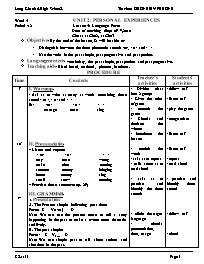Thiết kế bài dạy Tiếng Anh 11 - Unit 2: Personal experiences - Lesson 5: Language focus

Objectives: By the end of the lesson, Ss will be able to:
- Distinguish between the three phonemic sounds /m/, / n / and / /
- Use the verbs in the past simple, past progressive and past perfect.
Language contents: vocabulary, the past simple, past perfect and past progressive.
Teaching aids : Black board, textbook, pictures, handouts.
Bạn đang xem tài liệu "Thiết kế bài dạy Tiếng Anh 11 - Unit 2: Personal experiences - Lesson 5: Language focus", để tải tài liệu gốc về máy bạn click vào nút DOWNLOAD ở trên
Week 4 UNIT 2: PERSONAL EXPERIENCES Period :12 Lesson 5: Language Focus Date of teaching :Sept 09 th,2010 Class: 11Cbo2, 11Cbo3 Objectives: By the end of the lesson, Ss will be able to: Distinguish between the three phonemic sounds /m/, / n / and / / Use the verbs in the past simple, past progressive and past perfect. Language contents: vocabulary, the past simple, past perfect and past progressive. Teaching aids : Black board, textbook, pictures, handouts. PROCEDURE Time Contents Teacher’s activities Students' activities 5’ 10’ 7’ 7’ 7’ 8’ 1’ I. Warm up : - Ask ss to write as many as words containing these sound / m /, / n / and / / Ex: /m / / n / / / manage nose sing II. Pronunciation: * Listen and repeat: / m/ / n / / / may nose wrong make nine running summer money bringing home money sing small snow morning * Practise these sentences:(p. 29) III. GRAMMAR: 1. Presentation: A. The Present simple indicating past time: Form: S + V(s/es) + O Use: We can use the present tense to tell a story happening in the past to make a events more dramatic and lively. B. The past simple: Form: S + V2/ed + O Use: We use simple past to talk about actions and situations in the past. C. The Past progressive: Form: S + Be (was/were) + V-ing Use: We use past continuous to talk about something which has in progress at a past time. The action and situation had started but it had not finished that time. Ex: At 8 o’clock last night, I was watching TV. - We often use the continuous and past simple together in a sentence. The past continuous describe a longer action or situation which was in progress at the past time. The past simple describes s shorter action which happened in the middle of the longer action, or interrupted it. D. The past perfect: Form: S + had + V3/ed + O Use: We use past perfect to talk about something which had happened before the past time we are thinking about. Ex: We arrived at the cinema at 8.00 but the film had started at 7.00. 2. Practice: Exercise 1: (p.30) Answer key: 1. invites 2. sets 3. gets 4. waves 5. promises 6. carries 7. contains 8. has basked 9. is 10. is shining 11. are singing 12. is Exercise 2: (p. 30) Answer key: 1. broke / was playing 2. wrote / was 3. was working / broke 4. started / were walking 5. told / were having 6. didn’t listen / was thinking 7. phoned / didn’t answer / were (you) doing 8. was not wearing / didn’t notice / was driving Exercise 3: (p.31) Answer key: 1. had eaten / arrived 2. found / had taken 3. got / had closed 4. got / had left 5. got / had arrived 6. paid / had phoned 7. went / said / hadn’t arrived 8. had looked / asked / cost V. Homework : - Finish the exercise at home. - Prepare the next lesson (Reading-p.22) - Divides class into 2 groups - Gives the rules of game - controls the game - Checks and declares the winner - Introduces the lesson - models the words - asks ss to repeat - calls some ss to read aloud - asks ss to practise and identify the three sounds - elicits the target language - checks pronunciation, form, usage - Runs through - asks ss to do the exercise - Asks ss to give the answer - Gives feedback - Runs through - asks ss to do the exercise - Asks ss to give the answer - Gives feedback - Runs through - asks ss to do the exercise - Asks ss to give the answer - Gives feedback - asks . - follow to T - listen to T - play the game - congratulate - listen to T - listen to T - repeat - read aloud - practise and identify three sound - follow to T - check - listen to T - do the exercise - give the answer - Listen To T - listen to T - do the exercise - give the answer - Listen To T - listen to T - do the exercise - give the answer - Listen To T - listen
Tài liệu đính kèm:
 UNIT2-LANGUAGE FOCUS-LOP 11.doc
UNIT2-LANGUAGE FOCUS-LOP 11.doc





